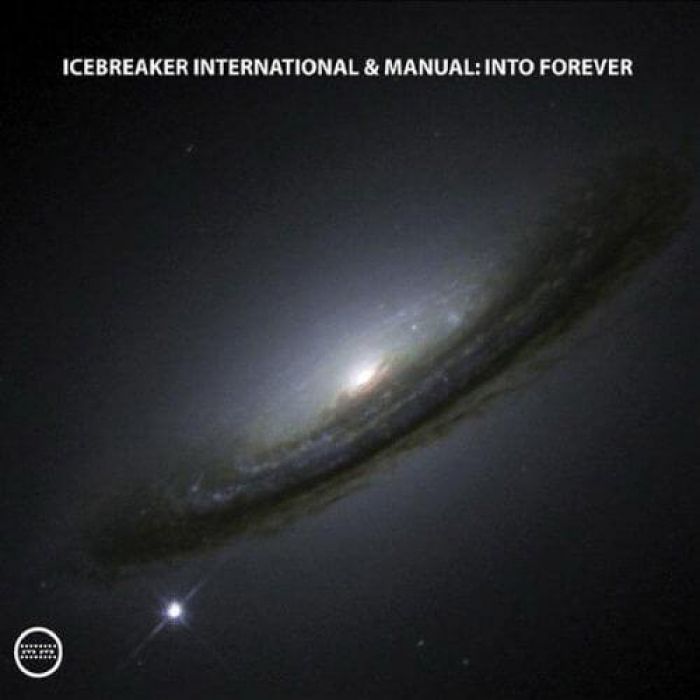Into Forever by Icebreaker International, Manual (Review)

I think I rolled my eyes when I first saw Into Forever, with that swirling galactic cloud on the cover, and read the song titles. And I probably groaned inwardly when I saw the album’s concept: that these songs were recorded as messages to be sent, via satellite, to the inhabitants of some other galaxy. “Of course!” I thought to myself. “When you make ambient music set in space, you should explain it with some cheesy sci-fi concept, wrap it all up with some New Age-y titles, and slap a photo from NASA’s Hubble archives on the front. After all, this is outer space we’re talking about here.”
Everything about the album just seemed too obvious, an attempt to make it seem much more grandiose than it actually was. Being the cynic that I am, I was fairly certain the album would fail to live up to its own claims, that it would end up sounding like some subpar Steve Roach protege you might hear on Hearts of Space. And as I began listening to the album, I certainly heard nothing that assuaged my doubts. Not surprisingly, it sounded like music for an episode of Nova or Star Hustler, or perhaps some PBS documentary about radio telescope arrays. But the more I listened to Into Forever, the more I found my skepticism disappearing.
Unlike Steve Roach’s The Magnificent Void, Jonas Munk (Manual, Limp) and Alexander Perls (Icebreaker International, Piano Magic) don’t try to dredge of titanic wells of vast, alien sound. Nor do they attempt to sing of the bleakness and terror that lurks in the interstellar depths à la Lustmord or Arecibo. Instead, there’s something childlike and naïve, silly almost, about Into Forever’s sounds, which is why it works so well. There’s a sense of wonder and innocence at play, as if these songs were composed by starry-eyed children inspired by their first visit to the planetarium.
Much of Into Forever consists of huge sonic drifts that suggest panoramas like those in Contact’s climactic journey (or maybe Star Trek: Voyager’s opening credits) — scenes full of colorful nebulae, supernovae, and stellar nurseries. During these stretches, the listener just hangs in freefall, unable to do anything except try to drink it all in. Through “The Countdown,” chiming notes and huge walls of sound rush by, creating the sensation of plunging through some vast dust cloud in your tiny craft.
As you travel into “The Inner Rings,” and hear those vast drones grow in size and scope, it’s difficult not to imagine stellar choirs and extraterrestrial cathedrals. Occasionally, signs of life can be heard in the vacuum. Wordless vocals coo along with the album’s graceful guitars and shuddering synths, sounding almost like a choir of 2001’s star children. The song ends with a poignant little denouement, like something for an astronaut bidding goodbye to his loved ones as he begins a lifelong journey to some distant star. Those vocoderized coos resurface on “A Turning,” this time sounding a bit more pensive while surrounded by metallic synths and a shower of guitar notes.
Though most of the album is shapeless and without form, the drones do occasionally fall away, revealing song-like structures. Crystalline guitar notes ring out from “A Turning,” glinting in the darkness like starlight reflected off a starship’s hull. Meanwhile, the pitter-patter of Munk’s programming sounds like a swarm of tiny asteroids bouncing off a satellite’s thin metal skin. However, even “Beacons,” the closest thing to an definable song on the album, never truly loses its cosmic scope, and as it gets absorbed back into the expanse of “Now Forever,” the listener is once again left drifting there in freefall, trying to drink in a splendor that words fail to describe.
Given the mess we humans are making of things here on Earth these days, Lord only knows what messages we’re sending to any intelligent lifeforms that might be taking a gander right now. However, with its warmth and beauty, Into Forever is one transmission I wouldn’t mind broadcasting to the stars. If first contact does occur sometime in the future, I’d like to think that our extraterrestrial brethren’s first impressions might be based on these signals full of child-like wonder. I just hope that, given our species’ self-destructive tendencies, we can live up to them.